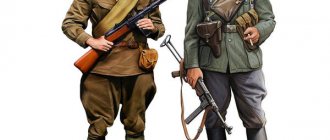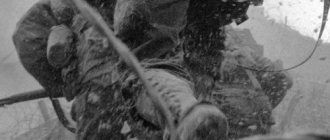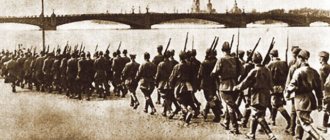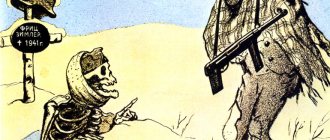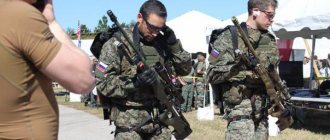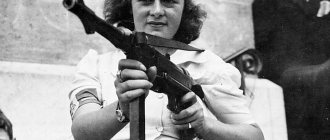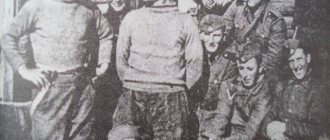Trophy items of German soldiers and officers from the Second World War
Traces of the past war were and are everywhere in the western direction.
When you go on vacation to pick mushrooms, you can see trenches overgrown with young animals at the edge of the forest. I went a little further into the forest and dugouts covered in moss appeared. And sometimes you have to step over rusty barbed wire that has grown into the tree trunk. A helmet found in the attic or a rusty bayonet is a treasure for any boy. Many people developed an interest in military antiques at that time. It’s not a fact that today’s youth (the “Pepsi” generation), who grew up watching American action films, will also show such an interest in military antiques, be they Soviet or German... And what special energy do collectible pieces of captured German weapons or equipment carry? Military equipment, aviation, artillery, firearms, weapon accessories and equipment - all this, in general, is the level of development of science and technology of a particular power. Since it is military technologies that are always one step ahead of civilian ones. The technical superiority of the army of the Third Reich in many areas of military affairs cannot be denied. The victorious march of the Wehrmacht across Europe, the huge losses of the Red Army in the first years of the Second World War - all these are indicators of the power of the German military machine, using advanced technologies and innovative methods of warfare. Collecting trophies of the Third Reich: equipment, uniforms and weapons has nothing to do with ideological views and National Socialist ideas. On the contrary, it is necessary to preserve the trophies of the Second World War - the cultural and historical value of which cannot be underestimated. We need to know what strong enemy our grandfathers defeated: how the enemy was equipped, what ammunition and equipment the enemy had.
Wehrmacht ammunition and equipment
Tablets, bags, binoculars, flashlights of German soldiers of the Third Reich. German officer's field tablet,
or a bag for maps, model 1935, was made of smooth or grained leather: brown in different shades for the army, black for the SS troops. It was also used by senior non-commissioned officers. During the war, the color changed to gray, and natural leather changed to artificial leather. Inside the tablet there were partitions, transparent celluloid plates for cards. On the front wall of the case there were leather pockets for pencils - usually along a pocket for a coordinate ruler - and sockets for other tools. There were different options for their placement: along with standard official ones, commercial products were used. The valve could cover the tablet entirely, half, or only its upper third, fastening either with a leather tongue with a buckle, or with a bracket passing through the slots in the plates riveted to the valve - the tongue of the lid was passed into it. Domestic field bags were closed in a similar way. German tablets were worn either by hanging them from loops on a waist belt, or on a heavy-duty strap with an adjustable buckle. Almost all binoculars were equipped with a neck strap with a fastened leather or plastic cover to protect the eyepieces and a leather loop attached to the body frame for fastening to a jacket button. State-made binoculars were covered with black ersatz leather and painted feldgrau or dark yellow; Frequent companies used genuine leather and black varnish for these purposes. The cases were made from natural or artificial leather - black or brown, as well as from plastics such as Bakelite; On the sides there were half rings for fastening a belt, and on the back wall there were leather loops for a belt. The lid clasp was elastic. with a peephole on the tongue and a peg on the body of the case; There were also spring ones, like on gas mask cases. The location of the binocular case was determined by the presence of other equipment.
There were many examples of service flashlights with color signal or camouflage filters. The rectangular body, metal or plastic, was painted black, feldgrau. dark yellow, and turned white in winter. A leather loop was attached to the back for attaching clothing or other similar devices to a button. Bag of a Hauptfeldwebel - company sergeant major
, in which he kept report forms, personnel lists, and writing materials. — it had no fastenings and, according to tradition, was worn tucked over the side of a tunic or jacket.
The standard equipment of the infantryman was basic for many other branches of the military. Its basis was a waist belt - mainly made of thick smooth leather, black, less often brown, about 5 cm wide. On the right end was put a stamped aluminum or steel (and at the end of the war, bakelite) buckle with a grained or smooth surface, silver or painted in color feldgrau, khaki, gray. Stamped in the center was a round medallion with an imperial eagle surrounded by the motto “God is with us.” The buckle was adjusted using a tongue sewn to the belt with paired holes into which the teeth of the inner sleeve entered. The hook of the left end of the belt was hooked into the loop of the buckle.
The next important component of German WWII equipment
There were Y-shaped support belts - two strong ones and a back one. Similar ones were used back in the First World War, and in 1939 new ones were introduced, with riveted side straps for a backpack of the same year or a combat backrest. The tapered ends of the shoulders with sewn leather stops had a series of holes into which the teeth of the adjusting buckles entered: the galvanized buckles ended with wide stamped hooks that clung to semicircular or quadrangular rings of pouches or movable belt couplings. The length of the side straps with rings was adjusted with cufflinks and slots, as was the case with the back strap, which was hooked from below to the middle of the belt, and for a tall soldier - to the ring of the movable coupling. The backrest was connected to the shoulder straps by a large round ring with a leather washer. On the back of the shoulders. above the central ring, large half rings were sewn for attaching the upper hooks of marching or assault backpacks, as well as other ammunition. Simplified canvas equipment for a similar purpose was used in North Africa along with leather, and after the surrender of the “Africa” army in May 1943, it began to be produced for continental troops, mainly in the Western theater of operations. However, at the end of the war, canvas belts, from greenish-yellow to dark brown, were found in abundance on the Eastern Front.
Aluminum flask from 1931
.. with a capacity of 800 ml, with a screw cap and an oval cup, painted gray or black, later olive green.
A strap with a buckle that fit into the brackets on the cup and went around the flask vertically in front and behind. was threaded through leather belt loops on a felt-colored or brown cloth cover, which was fastened on the side with three buttons, and its flat carabiner hook was fastened to the half-rings of equipment or a cracker bag. At the end of the war, steel flasks appeared - enameled or covered with red-brown phenolic rubber, which protected the contents only from frost - in this case, the flask had an additional strap around the circumference. Conical drinking cups could be made of steel or black bakelite; they were also pulled together by a strap pulled into brackets. German mountain troops
and orderlies used one and a half liter flasks of a similar device. discontinued in 1943
Combined German bowler model 1931.
copied in many countries, including the USSR, was made of aluminum, and since 1943 - of steel.
Until April 1941, 1.7-liter pots were painted gray, then they switched to olive green (however, the paint was often peeled off in the field). A fastening strap was passed into the brackets of the folding handle of the bowl lid. If there were old backpacks, the bowler was worn outside, with later ones - inside them. In a lightweight display, it was either fastened to a cracker bag next to the flask, or clung to a back strap or to a braided combat pack. NZ was kept inside the cauldron. Anti-chemical and protective equipment in the German Wehrmacht. The cylindrical German gas mask canister case
had a longitudinally corrugated surface and a lid with a hinged hinge and a spring latch.
A shoulder strap made of braid was attached to the two brackets at the lid, and to the bracket at the bottom there was a strap with a hook that clung to the belt or to the rings of the equipment. In the case of the 1930 model, a gas mask of the same type was usually placed with a mask made of rubberized fabric, with a round filter screwed onto the stigma and with tightening elastic straps made of rubber-fabric braid. The case for the gas mask of the 1938 model had a lid of shallower depth. and the mask is entirely rubber. The lid contained a box with a degassing agent and napkins. The factory color of the gas mask cases was fel dgrau, but on the Eastern Front they were often repainted. and in winter they covered it with whitewash or lime. Gas mask cases for German WWII soldiers, 1930 and 1938 models.
were interchangeable. According to the rules in the infantry, the gas mask was placed with the lid forward over a bag of crackers, slightly below the waist belt, but also with the lid backwards - how. for example, machine gunners or those whose equipment blocked the gas mask. A shoulder strap and hook strap kept the case in a nearly horizontal position. Drivers and motorcyclists wore a gas mask on a shortened strap horizontally on the chest, with the lid facing to the right; cavalrymen - on the right thigh, passing the strap under the waist belt; in mountain troops - horizontally, behind the backpack, with the lid to the right. In transport vehicles, the gas mask case was released from the strap and placed on the knee. Well, in combat conditions it was positioned however it was more convenient for anyone - on the left side, vertically, on a shoulder strap, and attached to the equipment.
On our website Antik1941 you can buy original items of equipment of German soldiers and officers from 1939-1941
Oilcloth bag for an anti-chemical (“anti-spirit”) cape
was fastened to the strap of the gas mask case or directly to its corrugated canister. The triangular raincoat of the 1931 model was cut from impregnated cotton gabardine with a three-color “splintered” camouflage pattern - dark on one side and light on the other (at the end of the war the pattern was dark on both sides). The slot for the head in the center was covered with two flaps. The tent could be worn like a poncho, and with the buttoned flaps it was a kind of cloak. There were ways to wear it for walking, riding a motorcycle and riding a horse. The tent was used as a bedding or pillow, and two - stuffed with hay and rolled into a bag - served as a good floating device. With the help of loops and buttons along the edges, sections of tents could be joined into large panels for group shelters. Eyelets at the corners and on the sides of the middle seam at the base made it possible to tension the panel with ropes and stakes during installation. A rolled-up tent and a bag with accessories for it were carried, attached either to shoulder straps, or to an assault pack, or at the belt. They attached it to the backpack or put it inside it. At the end of the war, tents were supplied only to selected field units. Therefore, the German army did not disdain the old square ones from the time of Kaiser Wilhelm II and captured Soviet ones with a hood.
Both laughter and sin: winter equipment of Wehrmacht soldiers in 1941-1942
The issue of the absolutely failed provision by the military and state leadership of the Third Reich of its own army, which fought on the Eastern Front, with winter uniforms and equipment remains for many to this day one of the most inexplicable mysteries of the war period.
How could the Germans, with their pedantry and desire to take into account every detail, miscalculate so cruelly and actually give their soldiers to be slaughtered by “General Moroz”? Surely each of us knows photographs of soldiers of the German and allied forces who surrendered after the crushing defeat at Stalingrad. This audience looks most pitiful, downright ridiculous - mostly because instead of military uniforms, these “conquerors”, in an attempt to escape the severe frost, put on something unimaginable. Women's scarves and cloaks, pieces of carpets and curtains, bundles of straw on their feet... There is only one shame, not an army!
I’ll tell you a little secret: Soviet military photojournalists then had big problems - the editors flatly refused to accept footage, after viewing which one got the impression that the Red Army in fierce battles had defeated not the most powerful army in Europe, but a gang of some wretched ballers. However, there were no others available. Incredible, but true: during the first two war years, the Wehrmacht command was never able to establish a normal supply of field infantry units with equipment suitable for the winter war.
Generally speaking, this story is an excellent lesson for those who love to extol our “civilized” and “highly organized” enemies, whom the “gray-legged Red Army soldiers” led by “illiterate marshals” only managed to “overwhelm with corpses.” Okay, in Germany they always despised the French and, obviously, because of this, they did not value the memoirs of those of them who became victims of “General Frost” in 1812. But the Germans themselves not only fought, but also lodged on the European territory of the USSR during the First World War and the Civil War! And many of those who then fully experienced the delights of our winter were in the ranks of the Wehrmacht in 1941, including in command positions.
And yet, when starting the war with the Soviet Union in 1941, the Nazis generally planned to provide only every fifth soldier with winter uniforms! This is not fiction, but the testimony of Colonel General Guderian. Their colossal self-confidence let them down: they expected to end the war in six weeks, after which they could relax in the captured “winter apartments.” The fact that the “blitzkrieg” would not take place, or at least would not meet the originally planned deadlines, became clear by the end of the summer. In any case, the Wehrmacht High Command only spoke about the need to supply its own personnel with winter clothing only on August 30, 1941.
Each soldier was planned to be blessed with two sets of cloth uniforms appropriate to the climate: a hat, headphones, warm gloves, a scarf, a fur vest, woolen socks and even three woolen blankets in addition. Nevertheless, being confident that the main hostilities would be completed before the cold weather, they did not involve the main capacities of the defense industry in supporting this task, “outsourcing” it to secondary enterprises. As a result, it was essentially disrupted.
How did the “Aryans” greet the Russian frosts, which struck already in November 1941, and by December reached -30 degrees and below? Let's start with perhaps the most important thing - shoes. European “civilizers” did not recognize such a “barbaric” look as felt boots. They fought in boots and boots. And for the most part, not even in foot wraps, but in socks. Moreover, the soles of German army boots lined with iron spikes in severe frosts almost guaranteed frostbite on the feet and toes. Hence the wild-looking “ersatz felt boots” made of straw and any other rubbish that came to hand.
The headdress of the German infantryman was a cap. No matter how hard the occupiers tried to pull these cloth rags over their ears turning into ice, there was no point. By the way, German-made earflaps were available in nature, but they went to the personnel of the SS and Luftwaffe troops, whose leaders showed much more foresight than the “stripe wearers” from the Wehrmacht. As a result, ordinary infantry screwed whatever they could onto their heads.
The overcoat of the “Aryan” conquerors is a separate issue altogether. Not only was it made from fairly thin cloth, but it was also shortened, “shot” by our standards. Subsequently, already in 1942, this main piece of uniform was lengthened by 15-20 centimeters and they began to attach cloth hoods and various lining options to it. It is clear that the rest of the uniform (tunic, trousers, underwear) was also “summer”, light, and did not protect against the cold at all. It is not surprising that the most popular trophy among the frozen Germans in winter were our quilted jackets and especially sheepskin coats. It got to the point that they removed the overcoats from the killed Red Army soldiers - they were better, more practical and warmer.
Generally speaking, looting in all its forms (primarily among civilians) was the main way for Wehrmacht soldiers to replenish their own winter “wardrobe” in 1941-1942. Yes, a broad campaign was announced in Germany to collect winter clothes to send them to the Eastern Front, but not everyone had enough. And what kind of warm clothes do the Germans have?! In fact, the rear of the Third Reich had to develop winter uniforms from scratch. At the very least, the process of creating a Wintertarnanzug (winter double-sided set) for the Wehrmacht infantry, which included a warm jacket, trousers, liner and mittens, was completed only by April 1942, and it began to arrive in the troops no earlier than October of the same year.
What is typical is that the group that fought for Stalingrad did not receive this new uniform at all! About 80 carriages with it remained in the rear. Why this happened is completely incomprehensible, because back in December 1941, the same Guderian personally reported to Hitler that in some Wehrmacht units, losses from frostbite were twice the damage received from Russian bullets! Until 1943, the German infantry did not have normal winter equipment as such. And yet, let’s not forget that it was not “General Frost” who defeated the Nazis - it was our heroic grandfathers and great-grandfathers who defeated them!
LiveInternetLiveInternet
The basic personal field equipment of German infantry and other dismounted units consisted of a coherent system of items designed to complement each other during use. Despite the fact that many soldiers wore some kind of special equipment, the basic equipment was the same for everyone.
At the beginning of the war, the equipment consisted of a leather waist belt, to which a cartridge bag was suspended from the front right and left. Magazine bags for small arms of other types, except rifles (submachine guns, assault rifles), were included in the kit of these weapons. The belt straps (adopted for equipment along with the new backpack in 1939) were attached to the belt from the back and front at the level of the cartridge bags. Thus, an integral set was obtained, consisting of a waist belt, a sword belt and two cartridge bags. The cracker bag was attached to the waist belt at the back right, while the flask was worn on top of the cracker. The sapper blade was also located on the belt behind the back, but on the left, on top of the blade, a sheath for a bayonet knife was attached. The gas mask, placed inside a cylindrical tin box, was suspended on a separate belt over the left shoulder and secured to the belt above the cracker bag. Several ways of wearing a gas mask were proposed, depending on the specific characteristics of the service. The gas protective cape was stored in a bag attached to the belt of the gas mask box at chest level. If the soldier did not wear a satchel, then he attached the bowler hat to the “cooker”, next to the flask, or hung it on the sword belt. The cloak-tent (combining a cape, overalls and tent) was usually attached to a sword belt above the flask.
Such equipment allowed the soldier to operate on the battlefield for 24 hours, since it contained ammunition, auxiliary weapons (bayonet), rations, water, a pot and various useful items. In addition, the equipment included items that made it easier for a soldier to survive on the battlefield: a gas mask, a gas-protective cape, a sapper shovel and a raincoat.
Soldiers carried additional items of equipment in a combat backpack, introduced shortly before the war. A small bag for additional items was suspended from the backpack frame, attached to the belt. A raincoat with accessories was also suspended from the machine, and a bowler hat was crowned on top of the entire structure. Heavier items were stored in a knapsack, in which soldiers usually carried spare underwear, warm clothes, rations and personal hygiene items.
The satchel was secured with shoulder straps to the waist belt. Just before the war, a model of a satchel appeared, attached directly to a sword belt. Such equipment for a soldier was called marching equipment. In addition, the soldiers were given small canvas bags in which a change of linen was stored. In combat conditions, soldiers handed over their backpacks and laundry bags to the convoy.
The equipment system was organized in such a way that the unit commander had a lot of room for maneuver - each soldier went on a mission carrying some special equipment. Already during the war, additional elements of equipment were introduced and different ways of wearing them were provided - statutory and non-statutory, facilitating the use of equipment in battle.
German infantry in battles near Kharkov, autumn 1941. In the center of the photo, with his back to us, stands the 3rd number of the machine gun crew of the infantry squad. His equipment consists of a cracker bag worn clearly at the back, a flask and a bowler hat fastened to the cracker, a raincoat and a shovel with a bayonet on the left side. In addition to the standard equipment, the soldier also carries a case with two spare barrels and an ammunition box for the MG-34 machine gun. The photograph shows that in combat conditions, soldiers wore their equipment as it was most convenient for them, and not as required by the regulations.
The field equipment of Wehrmacht soldiers was comfortable and contained all the items necessary in battle. The photo shows an example of wearing equipment; the raincoat and bowler hat are attached to the combat backpack.
